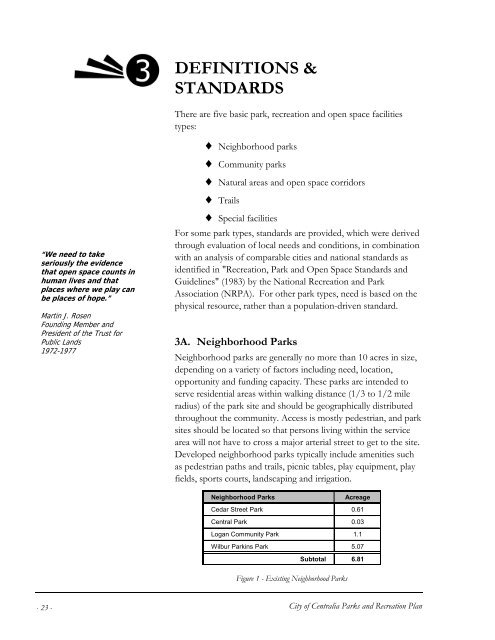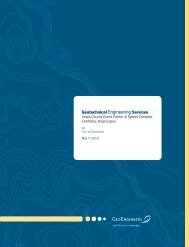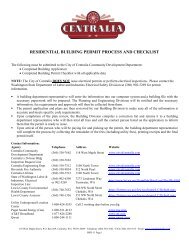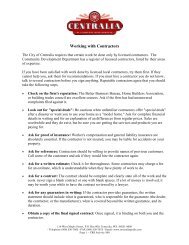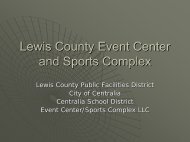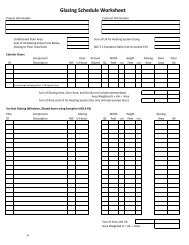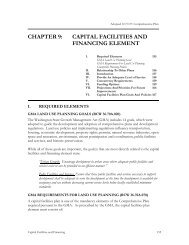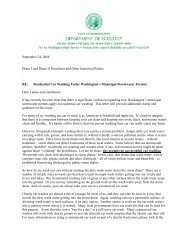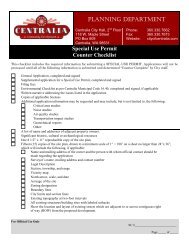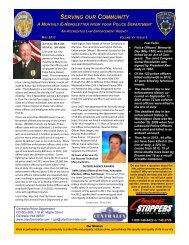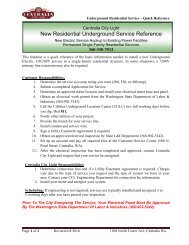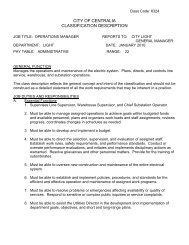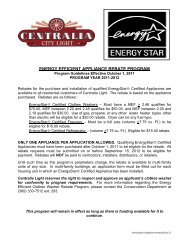Centralia Parks and Recreation Master Plan - City of Centralia, WA
Centralia Parks and Recreation Master Plan - City of Centralia, WA
Centralia Parks and Recreation Master Plan - City of Centralia, WA
You also want an ePaper? Increase the reach of your titles
YUMPU automatically turns print PDFs into web optimized ePapers that Google loves.
DEFINITIONS &<br />
STANDARDS<br />
There are five basic park, recreation <strong>and</strong> open space facilities<br />
types:<br />
“We need to take<br />
seriously the evidence<br />
that open space counts in<br />
human lives <strong>and</strong> that<br />
places where we play can<br />
be places <strong>of</strong> hope.”<br />
Martin J. Rosen<br />
Founding Member <strong>and</strong><br />
President <strong>of</strong> the Trust for<br />
Public L<strong>and</strong>s<br />
1972-1977<br />
♦ Neighborhood parks<br />
♦ Community parks<br />
♦ Natural areas <strong>and</strong> open space corridors<br />
♦ Trails<br />
♦ Special facilities<br />
For some park types, st<strong>and</strong>ards are provided, which were derived<br />
through evaluation <strong>of</strong> local needs <strong>and</strong> conditions, in combination<br />
with an analysis <strong>of</strong> comparable cities <strong>and</strong> national st<strong>and</strong>ards as<br />
identified in "<strong>Recreation</strong>, Park <strong>and</strong> Open Space St<strong>and</strong>ards <strong>and</strong><br />
Guidelines" (1983) by the National <strong>Recreation</strong> <strong>and</strong> Park<br />
Association (NRPA). For other park types, need is based on the<br />
physical resource, rather than a population-driven st<strong>and</strong>ard.<br />
3A. Neighborhood <strong>Parks</strong><br />
Neighborhood parks are generally no more than 10 acres in size,<br />
depending on a variety <strong>of</strong> factors including need, location,<br />
opportunity <strong>and</strong> funding capacity. These parks are intended to<br />
serve residential areas within walking distance (1/3 to 1/2 mile<br />
radius) <strong>of</strong> the park site <strong>and</strong> should be geographically distributed<br />
throughout the community. Access is mostly pedestrian, <strong>and</strong> park<br />
sites should be located so that persons living within the service<br />
area will not have to cross a major arterial street to get to the site.<br />
Developed neighborhood parks typically include amenities such<br />
as pedestrian paths <strong>and</strong> trails, picnic tables, play equipment, play<br />
fields, sports courts, l<strong>and</strong>scaping <strong>and</strong> irrigation.<br />
Neighborhood <strong>Parks</strong><br />
Acreage<br />
Cedar Street Park 0.61<br />
Central Park 0.03<br />
Logan Community Park 1.1<br />
Wilbur Parkins Park 5.07<br />
Subtotal 6.81<br />
Figure 1 - Existing Neighborhood <strong>Parks</strong><br />
- 23 -<br />
<strong>City</strong> <strong>of</strong> <strong>Centralia</strong> <strong>Parks</strong> <strong>and</strong> <strong>Recreation</strong> <strong>Plan</strong>


